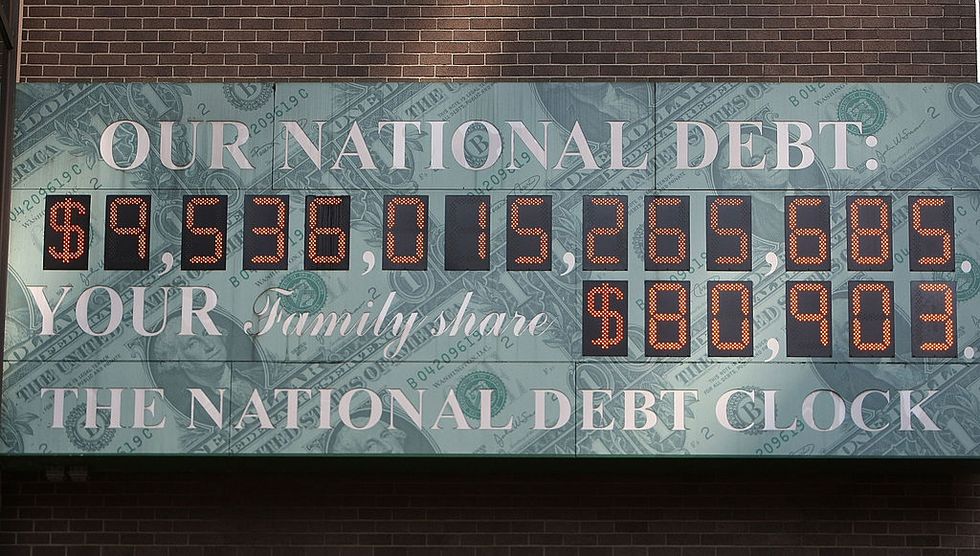Jeremy Lott
America is in a world of hurt financially. The U.S. government’s deficit for fiscal year 2015 was $439 billion, a figure that has actually been celebrated by the Obama administration since it’s so far down from the peak deficit of $1.4 trillion and change in fiscal year 2009.
Yet it isn’t much to celebrate, and the underlying news is much worse.
 The unofficial 'National Debt Clock' advertises the debt of the United States in midtown September 18, 2008 in New York City. Morgan Stanley and Wachovia Corp. are reportedly discussing a possible merger following the collapse of Lehman Brothers Holdings Inc. (Photo by Mario Tama/Getty Images)
The unofficial 'National Debt Clock' advertises the debt of the United States in midtown September 18, 2008 in New York City. Morgan Stanley and Wachovia Corp. are reportedly discussing a possible merger following the collapse of Lehman Brothers Holdings Inc. (Photo by Mario Tama/Getty Images)
A report by the respected, bipartisan Committee for a Responsible Federal Budget (CRFB) chides the administration by saying that “simply citing the 70 percent fall in deficits over the past six years without context is misleading, since it follows an almost 800 percent increase that brought deficits to record high spending levels.”
That whopping 800 percent increase came via bipartisan bailouts of the financial sector and then a massive stimulus bill, signed by Presidents George W. Bush and Barack Obama. It also came largely on top of already increased military spending for two expensive wars in Afghanistan and Iraq.
So government increased domestic spending like crazy at the same time revenues were plummeting as the private sector took it on the chin from the housing crunch. Many Americans continue to feel the effects of that crunch - having parked their nest eggs in real estate and lost big.
According to the same report, “Even as deficits have fallen, debt held by the public has continued to rise, growing from $5 trillion in 2007 and $7.5 trillion in 2009 to $13.1 trillion today. As a share of GDP, debt rose from 35 percent in 2007 to about 74 percent in 2014 and 2015.”
That private debt exists alongside $19.2 trillion of accumulated government debt, just at the federal level alone. And we haven’t even begun to contemplate the horror of the coming entitlement crunch, with perhaps $100 trillion of unfunded liabilities between Medicare and Social Security, if those programs continue on their present course.
Growth can help here, a bit. CRFB reports that “annual deficits have fallen substantially over the past six years, largely due to rapid increases in revenue (largely from the economic recovery), the reversal of one-time spending during the financial crisis, small decreases in defense spending, and slow growth in other areas.”
But credit ratings agencies have downgraded, or threatened to downgrade, U.S. debt for a reason. The deficit isn’t a problem that’s going to fix itself. The bedrock problem is that the federal government continues to spend far too much money. Spending, on domestic programs, on entitlements and, yes, on defense is going to have to be limited or capped or cut if Congress is to get serious about putting America’s financial house back in order.
It will be especially important that changing defense priorities become part of any bipartisan budget deal. America is the biggest military spender in the world -- and by a country mile. No country even comes close. No three countries even come close.
In fact, America spends more on its war-making capability than the next seven highest spending nations put together, according to the annual survey of the Stockholm International Peace Research Institute, which reported, “The United States, with total expenditure of $596 billion, remains by far the world’s largest military spender, at nearly three times the level of China, which is ranked second.”
We’re comparing year to fiscal year here, which can be tricky. But, roughly -- and only in theory, as a way of understanding these numbers -- we could have covered the whole $439 billion deficit with the $596 billion we spent on the military last year, with $157 billion left over. Even the difference between those two figures is more than the world’s number three spender, Saudi Arabia, shelled out.
This is not to suggest that military spending be cut back radically to $157 billion or anything remotely like that, but rather that defense spending ought to be rethought and recalibrated in light of the actual defense needs of our country. That would cost considerably less than the current “world policeman” role we’ve stumbled into.
We ought to build up and pay for a strategic, agile, world class military, always at the ready. But that can only be done if we confront our spending problem squarely, with bayonets fixed and that army of red ink in our crosshairs.
Jeremy Lott is a senior fellow at the American Security Initiative Foundation and a senior fellow at Defense Priorities.
–
TheBlaze contributor channel supports an open discourse on a range of views. The opinions expressed in this channel are solely those of each individual author.


 The unofficial 'National Debt Clock' advertises the debt of the United States in midtown September 18, 2008 in New York City. Morgan Stanley and Wachovia Corp. are reportedly discussing a possible merger following the collapse of Lehman Brothers Holdings Inc. (Photo by Mario Tama/Getty Images)
The unofficial 'National Debt Clock' advertises the debt of the United States in midtown September 18, 2008 in New York City. Morgan Stanley and Wachovia Corp. are reportedly discussing a possible merger following the collapse of Lehman Brothers Holdings Inc. (Photo by Mario Tama/Getty Images)


